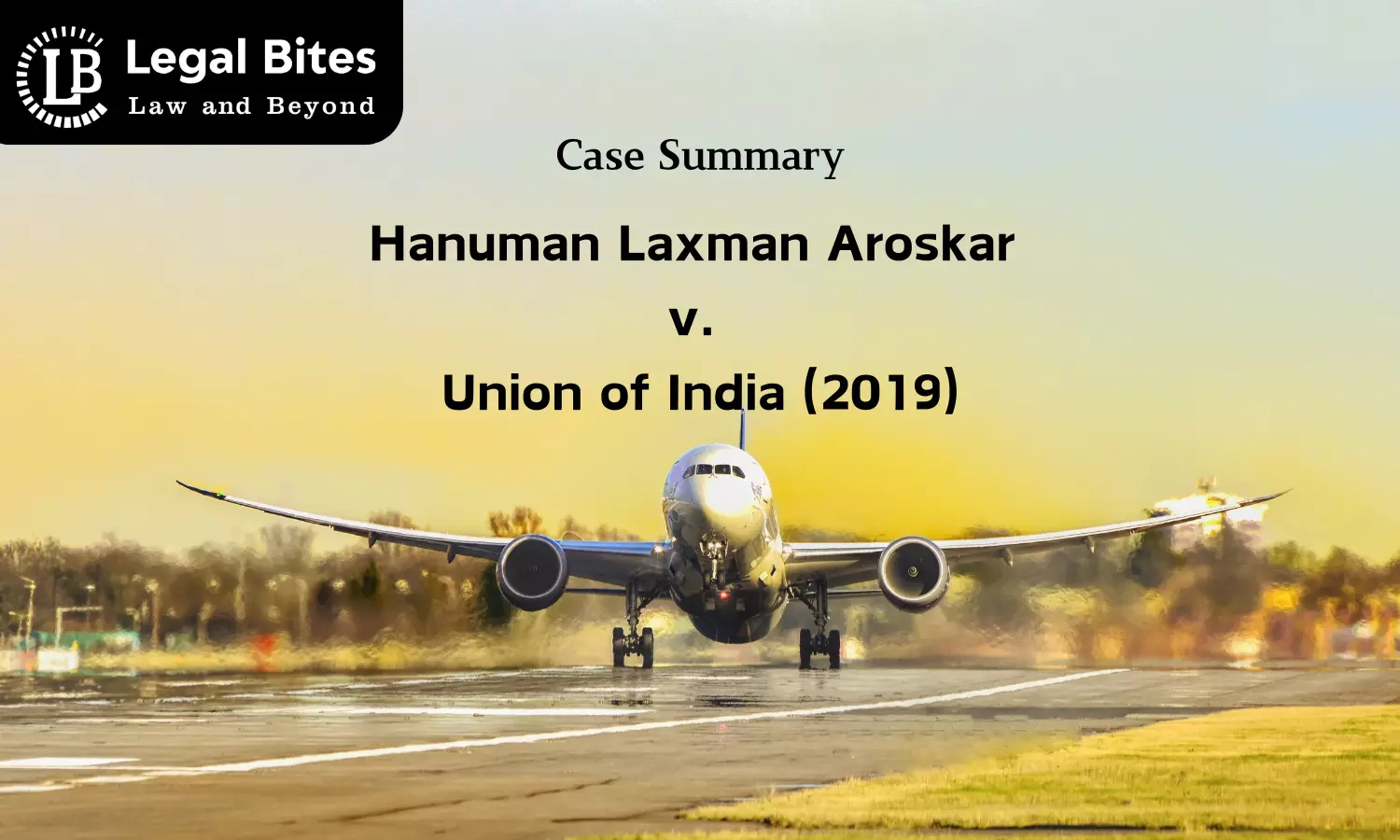Case Summary: Hanuman Laxman Aroskar v. Union of India (2019) | Judicial Review of Environmental Clearance
In Hanuman Laxman Aroskar v. Union of India (2019), the Supreme Court addressed issues with Environmental Clearance for large infrastructure projects.

The judgment reinforced the need for accountability and adherence to sustainable development principles in large infrastructure projects.Case Title: Hanuman Laxman Aroskar v. Union of IndiaCourt: Supreme Court of IndiaCitation: (2019) 15 SCC 401Bench: Justice Justice D.Y. Chandrachud and Justice Hemant GuptaDate of Judgment: March 29, 2019FactsAn appeal was filed before the Principal Bench of the National Green Tribunal (NGT) in New Delhi, challenging the Environmental Clearance (EC)...
The judgment reinforced the need for accountability and adherence to sustainable development principles in large infrastructure projects.
Case Title: Hanuman Laxman Aroskar v. Union of India
Court: Supreme Court of India
Citation: (2019) 15 SCC 401
Bench: Justice Justice D.Y. Chandrachud and Justice Hemant Gupta
Date of Judgment: March 29, 2019
Facts
An appeal was filed before the Principal Bench of the National Green Tribunal (NGT) in New Delhi, challenging the Environmental Clearance (EC) granted for the development of a greenfield international airport at Mopa in Goa. In its judgment dated 21 August 2018, the NGT upheld the EC, concluding that the project did not pose an environmental threat but required additional safeguards. The proposed Mopa airport is located 35 kilometres from Panaji, Goa, on a tabletop plateau surrounded by steep slopes. The existing Dabolim airport was operating at full capacity, leading the state government to initiate plans for a new airport in 1997, supported by several feasibility studies.
The project underwent comprehensive environmental assessments, including the submission of an Environmental Impact Assessment (EIA) report and public consultations. In 2015, the Expert Appraisal Committee (EAC) recommended the EC, which was approved by the Ministry of Environment and Forests (MoEF). Land acquisition for the project began in 2008, reducing the proposed airport area from 4,500 acres to 2,271 acres.
GMR Goa International Airport Limited (GGIAL) was awarded the construction contract in 2016 with a 40-year concession. Despite legal challenges, including issues surrounding tree felling at the site, the court authorized the process, which was completed by January 2019. The NGT’s decision was subsequently appealed before the Supreme Court.
Issue
Whether the Environmental Clearance for the airport project should be upheld, considering the alleged deficiencies in the Environmental Impact Assessment, including the failure to disclose critical information about tree felling, reserved forests, and Ecologically Sensitive Zones (ESZs), and the inadequacy of the appraisal process conducted by the Expert Appraisal Committee (EAC).
Arguments
Appellants' Argument
Material Concealment: The appellants argued that the Environmental Impact Assessment (EIA) report misrepresented the number of trees to be felled (54,676 trees), claiming only "a few trees" would be cleared.
Concealment of Ecologically Sensitive Zones (ESZs): The appellants contended that the EIA failed to mention the existence of reserved forests in Maharashtra and ESZs within 15 km of the project site, which is a significant omission.
Deficient Data: The appellants pointed out the lack of environmental data from Maharashtra, including soil, air, and water samples, and wildlife studies.
Public Consultation Issues: They highlighted that serious environmental concerns raised during public consultations were not adequately addressed by the project proponent before the Expert Appraisal Committee (EAC).
Flawed Appraisal Process: The appellants argued that the EAC did not properly review the EIA, citing vague recommendations and the lack of detailed reasons for granting the Environmental Clearance (EC).
MoEFCC's Argument
EIA Compliance: The MoEFCC countered the appellants’ claims, arguing that the EIA complied with the 2006 notification and that the EAC, consisting of experts, thoroughly reviewed the project and its impacts.
Forest and ESZ Data: The MoEFCC clarified that there were no reserved forests in Maharashtra within 15 km of the project site and emphasized that the EIA report included relevant data on forests and environmental parameters.
Faunal and Environmental Studies: The MoEFCC defended the EIA’s findings on biodiversity, including the identification of 385 plant species and 86 bird species within the study area.
State of Goa's Argument
Project Need: The Attorney General for the State of Goa argued the project was essential due to the saturation of the Dabolim airport and the growing passenger traffic in Goa.
Environmental Mitigation: The State emphasized that tree felling would be mitigated by planting ten trees for every tree felled, as well as by transplanting 500 trees under the supervision of the forest department.
Public Interest: The State highlighted that objections to the EIA process were procedural and should not outweigh the public benefits of the project.
Concessionaire's Argument
Project Progress: The Concessionaire detailed the progress of the airport project, including capital expenditures and milestones achieved, and argued that the project should not be halted.
Environmental Commitments: The Concessionaire reiterated its commitment to environmental mitigation measures, including tree planting and transplantation.
Judgment
The Supreme Court found that the Environmental Impact Assessment (EIA) process, including the appraisal by the Expert Appraisal Committee (EAC), was flawed due to the non-disclosure of critical information and inadequate review of the project's environmental consequences. The Court emphasized the importance of transparency and proper environmental governance in large infrastructure projects.
Non-Disclosure of Vital Information: The Court agreed with the appellants that the project proponent failed to disclose important details, such as the true extent of tree felling (54,676 trees), which impacted the environmental assessment process.
Failure of the EIA Process: The Court concluded that the EIA report was deficient, with important environmental concerns being overlooked, including the failure to account for Ecologically Sensitive Zones (ESZs) and reserved forests in the surrounding area. The Expert Appraisal Committee (EAC) did not adequately address these issues.
Suspension of Environmental Clearance (EC): The Court held that due process had not been followed in the approval process and directed the suspension of the Environmental Clearance granted to the project. The Court also directed the EAC to revisit its recommendations and reassess the project with due regard to the environmental concerns raised in the judgment.
Re-Evaluation of the Project: The EAC was tasked with revisiting its decision and considering additional environmental safeguards before allowing the project to proceed. The Court ordered the EAC to reconsider its conditions within a prescribed time frame, with the EC remaining suspended until the reassessment was completed.
Liberty to the State and MoEFCC: The Court granted the State of Goa and the MoEFCC liberty to submit the revised report of the EAC to the Court in the form of a Miscellaneous Application, which would facilitate the passing of final orders in the case.
Bona Fides of the Appellants: The Court rejected the argument that the appellants lacked bona fides in filing the appeal, recognizing their legitimate concerns regarding the non-consideration of important environmental issues. The Court affirmed the importance of judicial review in matters concerning environmental governance, especially for the benefit of future generations.
Click Here to Read the Full Judgment
Conclusion
The Supreme Court allowed the appeal, suspended the Environmental Clearance granted to the airport project, and directed the Expert Appraisal Committee (EAC) to reassess the project based on a comprehensive evaluation of its environmental impacts. The judgment reinforced the need for transparency, accountability, and adherence to environmental governance principles in large infrastructure projects.

Apurva Neel
I am a Research Associate and Editor at Legal Bites with an LL.M. specialization in Corporate and Commercial Laws from Amity University, Mumbai. I have put my best efforts into presenting socio-legal aspects of society through various seminars, conferences etc. I keep refining content as I am an ardent writer, and palpably law has got multi-dimensional aspect, so I passionately try to explore ahead.
